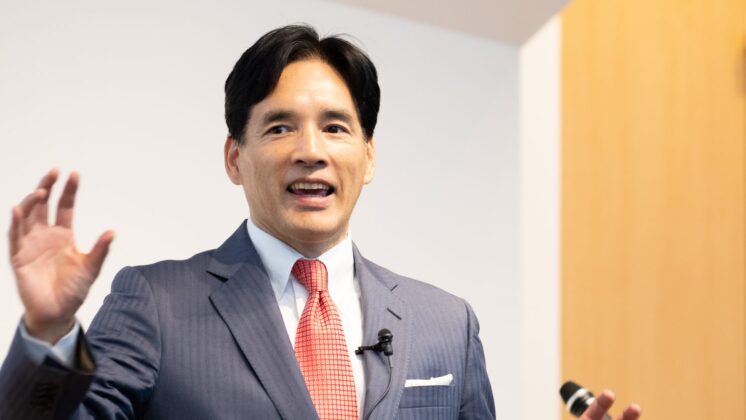The G1 Venture board meeting began at 7 a.m. Board members include Yoshikazu Tanaka of GREE, Daisuke Iwase of LifeNet Insurance Co., Takao Ozawa of YJ Capital Inc., Hiromichi Mizuno of Coller Capital, Takaaki Umezawa of A. T. Kearny Inc., and other powerhouses.
Between the board meetings, I saw off Kenichiro Mogi and others, and greeted more than 10 high school and university students who participated in G1 Youth.
From 8:30 a.m., the fourth breakout session began. Session 4-A “Japanese Internet Firms Break Through to the World.” YJ Capital Inc. COO Takao Ozawa, NHN Japan Corp. President Akira Morikawa, DeNA Co., Ltd. President Isao Moriyasu, and GLOBIS Capital Partners partner Shinichi Takamiya.
LINE is an essential application needed for communicating on smart phones, which demand simple, and faster service. It was Japan’s first global application and has exceeded 100 million users worldwide. (NHN Japan Corp. President Akira Morikawa, known for LINE and another app called “Naver Matome.”)
The Japanese Internet business is now prospering as much as it was during the Internet bubble. Japan’s Internet industry began with a model of importing goods from overseas. But in the field of mobile Internet, especially social games, Japan managed to beat Western nations for the first time. Japan is now gaining interest from foreign countries. (DeNA President Moriyasu)
Session 4-B “Abenomics from the Perspective of the International Monetary Market.”
Yuri Okina from the Japan Research Institute, Ltd., Makoto Takano from Pimco Japan Ltd., Hiromichi Mizuno from Coller Capital, and Jesper Koll from JP Morgan.
Session 4-C “Private-Sector Companies’ Role in the Community ~ A case study of a library in Takeo City, Saga Prefecture” Culture Convenience Club Co., Ltd. (CCC) President Muneaki Masuda and Takeo City Mayor Keisuke Hiwatashi. The moderator was the Boston Consulting Group (BCG)’s Reiko Akiike.
CCC President Masuda’s presentation has just begun, and it’s already very stimulating. (by Takeo City Mayor Keisuke Hiwatashi)
The session by CCC President Masuda and myself has ended. We had many people attend, such as Saki Corp. President Sakie Akiyama, Shinagawa Joshi Gakuin Principal Shihoko Urushi, Recruit Lifestyle Co., Ltd.’s Suguru Tomizuka, Seven & i Holdings Co., Ltd.’s Junro Ito, Lower House member Taro Kono, and Saga Governor Yasushi Furukawa. The very direct expressions by Mr. Masuda and myself got some good laughs. (By Takeo City Mayor Keisuke Hiwatashi)
Session 4-D “Action Statement II: Japan’s Ability to Disseminate Information”
Journalist Yoshiko Ikoma, Cafe Company Co. President Shujiro Kusumoto, Fleishman-Hillard Inc. President Shinichi Tanaka, A.T. Kearny Inc. Japan representative Takaaki Umezawa, Counselor at the Cabinet Secretariat of the Prime Minister’s Office Yoshimitsu Kaji.
Part Five all-attendee workshop “Initiatives from the G1 Summit III”
Breaking news (during the session) on the rankings of the most urgent issues chosen by participating leaders of each industry (in Japanese).
http://t.co/jB3uDS0I
The workshop debated the issues in 15 different groups. With Mie Governor Eikei Suzuki and Okayama Governor Ryuta Ibaragi at the politics table. (by Masaaki Taira)
“We will change Japan from G1. We hope to simultaneously trigger various initiatives. We are also planning to launch a new project called ‘the project to discover unknown politicians.’ We will change Japan with our friends. Let’s work together on this.” (I tweeted during the event.)
We listed specific ideas that came up during the session and I presented on what G1 should do based on those ideas. It was a very productive session that saw the birth of many ideas.
Lunch was the KIBOW Lunch. Four members passionately discussed their individual efforts following the March 2011 Great East Japan Earthquake. GRA director Hiroki Iwasa of Yamamoto Town, Miyagi Prefecture; Kenji Suzuki from Iwaki City, Fukushima Prefecture, Tomohiro Takei of Sendai MAKOTO, and Masahiko Haga of Kirikirikoku.
“Kirikirikoku. Fishermen who lost their jobs in the tsunami became wood cutters and launched a non-profit organization. They say that forestry is about receiving the gifts from predecessors from 40 years ago because they are chopping trees that were planted 40 years ago. Kirikirikoku is also planting trees in order to ‘pay it forward’ to those who will be living here 40 years from now. Those are nice words.” (by Fujiyo Ishiguro)
As soon as lunch finished, it was time for the Part Six Breakout Sessions.
Session 6-A was “Japan’s Space Development ~ What strategies can be used to achieve our wildest dreams?” Japan Aerospace Exploration Agency (JAXA) Senior Fellow Junichiro Kawaguchi, JAXA President Keiji Tachikawa, and lawmaker Kan Suzuki.
The border between rockets and airplanes will disappear. There is a need to think outside the box of “Using a rocket to launch a satellite.” We cannot downgrade ourselves from competing to become third in the world to third in Asia. Options of the direction of space development are: 1) inter-orbit transportation aircraft 2) winged return vehicle 3) supplying engines for freighters. (Junichiro Kawaguchi of the Hayabusa Project)
Space development requires a span of 30 years, but is conducted over five years in a span of 10 years. A short time span does not create long-term vision. Japan’s space development budget is one-tenth that of the U.S. This will not help space development take root. Currently, we are relying on Russia to launch to reach the manned space station. Is that acceptable? Shouldn’t Japan have similar capacity? Currently, only China, Russia and the U.S. have knowhow on manned launches. (JAXA President Tachikawa)
Session 6-B “Japan’s Beauty and Heart ~ disseminating them to the world”
This was a session by artist Hiroshi Senju and the Yamatane Museum of Art Director Taeko Yamasaki.
Session 6-C “Considering the Future of Energy from Fukushima”
Nobuo Ikeda, lawmaker Taro Kono, Akihiro Sawa. The moderator was GLOBIS University Graduate School of Management Dean Yoshihiko Takubo.
“Four breakout sessions are being held simultaneously at the G1 Summit. While attending each session, I run to the lobby to welcome VIPs and first-time guests as they arrive. At those times, I tell myself, ‘I feel bad about tweeting less compared with the World Economic Forum.’ Please understand my busy schedule as I’m an organizer. Instead, I plan to retweet from others much more.” (by Hori)
Session 6-D “Action Statement III Local administration: perspectives from municipal government management”
Okayama Governor Ryuta Ibaragi, Hiroshima Governor Hidehiko Yuzaki, Mie Governor Eikei Suzuki, Saga Governor Yasushi Furukawa, and Chiba City Mayor Toshihito Kumagai.
Yokosuka City Mayor Yuto Yoshida, Otsu City Mayor Naomi Koshi, Fukuoka City Mayor Soichiro Takashima, Takeo City Mayor Keisuke Hiwatashi, and Nara City Mayor Gen Nakagawa also joined in to announce the action statement.
The session stirred some meaningful discussions with local governments on one side and the economists in the audience adding different perspectives. Now, all we have to do is take action! (From Nara Mayor Nakagawa’s tweet)
The Part Seven plenary session “Recovery of Fukushima/Tohoku and the Re-creation of Japan” has begun. The panelists include Senior Vice Minister for Reconstruction Masayoshi Hamada, Lower House member Goshi Hosono, and Accenture President Chikatomo Hodo. The moderator is Keio University Graduate School of Media Design Professor Yoko Ishikura.
We are live streaming the session, so we can get feedback. I can reply to the comments immediately.
“I’m grateful. We will work hard to make Japan better.” “@junichisaito: The timeline has a lot of talk about the G1 Summit. I feel that GLOBIS is trying to improve society at large, going out of the boundaries of school. Japan is gaining energy through self-reflection. Respect.”
“I’m in the middle of the session. A G1 Youth high school student is presenting. The proposal is to start a “G1 peach tree” project. “We want to change Fukushima from the city of radiation to the prefecture of the peach. We will work hard to grow peach trees.” I couldn’t help but shed a tear. It’s great! G1 Youth started at the initiative of International School of Asia Karuizawa (ISAK) Executive Director Lin Kobayashi.
“Schools only teach the opinions of anti-nuclear activists. I wish that high school students would host symposiums on their own in which both the anti- and pro-nuke sides participate, then make decisions for themselves based on debates.” This opened up my eyes. I felt it was really convincing because the comment was made by mere children who will probably live here 20 or 30 years from now. (From Lin Kobayashi’s tweet)
Next is the KIBOW presentation. The team that won the prize at the previous KIBOW event made a presentation. “Sunflower seeds to Fukushima.” The goal is to create job opportunities, promote tourism, and counter negative rumors about Fukushima.
Part Eight plenary session “What are the Foundations of Nation Building?”
Yoshiko Sakurai, Seino President Yoshitaka Taguchi, DEFTA PARTNERS Group Chairman and Alliance Forum Foundation Chairman of the Board George Hara, Senior Vice-Minister for the Cabinet Office Yasutoshi Nishimura.
“People who cause friction create real reform. We need education that nurtures people who have pride in Japan.” (by Yoshiko Sakurai)
China is a country of 1) China-centric worldview 2) Communist Party supremacy and 3) military dominance. With these beliefs, the nation devised the use of its military power during times of peace. To compete with China, the U.S. and other nations are opting in the direction of 1) boosting their military power 2) and engaging in a battle of values. (by Yoshiko Sakurai)
China has aimed its offensive radar. It would have come as no surprise if there was a military conflict. A nation is like family. When the wife and children are in danger, the father’s role is to protect them. We need to deal with issues in a firm position and independent spirit. China’s budget for external information dissemination is 1 trillion yen. Japan’s is 13 billion yen. Why does Japan oppose the Trans-Pacific Partnership (TPP)? A nation will never grow unless it opens its doors. (by Yoshiko Sakurai)
The G1 Summit brings together leaders of diverse fields who can make social change. This creates debates with specifics, leads to action. So it’s stimulating. Yoshiko Sakurai speaks about Japan while touching on Japanese history. It’s convincing. (NHN’s Morikawa).
Yoshiko Sakurai gave us an explanation of the Charter Oath of Five Articles. When reading it again, we can understand very well that the oath is applicable to our current situation.
Then we had a panel discussion moderated by Senior Vice-Minister for the Cabinet Office Yasutoshi Nishimura.
“I served as moderator for a panel discussion, in which I discussed with Yoshiko Sakurai, Seino Holdings Inc. President Yoshitaka Taguchi, Alliance Forum Foundation’s George Hara about the role Japan should play in the world, Japan’s strengths and values, and other issues.” (tweeted by Senior Vice-Minister for the Cabinet Office Yasutoshi Nishimura)



